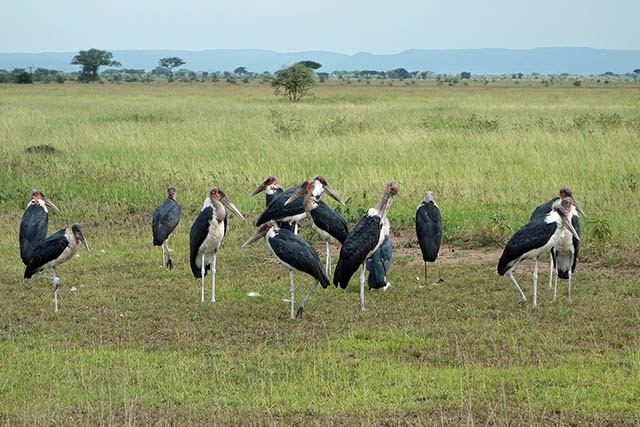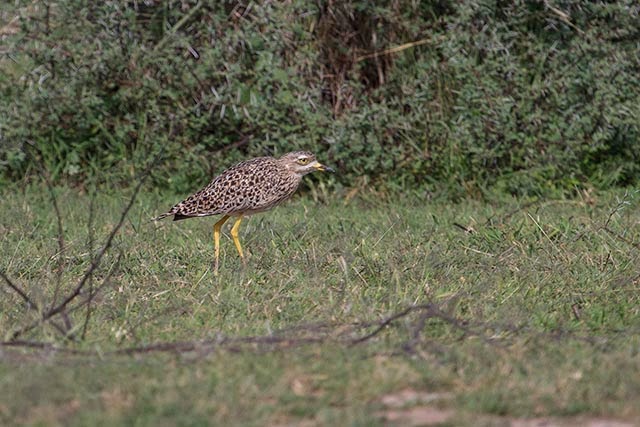We left the Serengeti Serena Lodge at 7.30 am. heading for the Serenity on the Lake Lodge on the shores of Lake Victoria. As usual, a long drive with stops to see game and birds as we drove out of the park and arriving in time for lunch. The Lodge was set in large grounds with chalets spread out under the trees, our two were right on the shoreline in prime position. Maybe this because we were the only guests! There were no phones in the rooms, just given whistles to blow on if there was an emergency...... hopefully someone might hear and come along. There was a heavy metal gate over the entrance door and an enormous padlock which was used to secure the chalet. More about that later.
After seeing several village or black headed weavers around the lodge we moved off and soon connected with several black-bellied bustards, red-naped larks, elephants, and impala etc..
Defassa waterbuck and calf
At last we saw a distant group of bat-eared foxes, this one showing the large ears - they are mainly insect eaters with termites making up 80% of their diet.
Red-naped Lark - the shaggy crest being quite diagnostic.
A group of marabou storks beside the track
Another two grey-crown cranes.
Black Coucal - the first time we came across these mainly because they like wet, swampy habitats and as we getting closer to L. Victoria we noticed the road/track had ditches and flooded areas alongside. Also, we were moving into a habitat with more trees and scrub and the weather was changing being more cloudy and humid. This was explained by Sidicki, the hot humid air stream coming in from the east hits the cooler air over L.Victoria causing rain and different weather.
Topi - easily identified by the hump on the shoulder and the pale brown legs and patches.
Dark Chanting Goshawk - we saw a couple of pale chanting goshawks (paler and yellow cere) but they were to quick for the camera.
Hamerkop
Black-headed Heron - the commonest and widespread in grasslands.
Brown Snake Eagle
African Open-billed Stork - We started to see more of these as we travelled through the wetter areas.
Yellow-throated Longclaw
Finally, we reached the exit gate from the Serengeti, Lake Victoria not far now. Whilst all the paper work was being done we were able to use the facilities and have a look round. This unidentified bat was hanging under one of the eaves of a building.
Yellow-winged Bat - by the exit gate.
In a nearby tree by the gate this Nubian woodpecker performed nicely for the camera. On route to the hotel we saw a few yellow-billed storks amongst the rice paddys.
Our chalet at 'Serenity on the Lake', large, felt a bit 'old colonial', note the large 'padlockable' iron gate at our door.
Plenty of room inside.
The view from the restaurant. At first lunch was being laid out on a table under the shelter on the left but in the distance we could here thunder and a few minutes later the wind got up. Too much, we asked to move inside and the storm really started to blow, all the glasses and cutlery etc all blew off the table smashing on the floor. Then the rain started, wow, that's what you call rain. After that twenty minute entertainment, lunch was ready, the best food served here during our two weeks. We spoke to the chef congratulating him on his skills, he told us he was trained in Nairobi. We also noted a Verraux's eagle owl perched in a tree next to the restaurant.
The wind, from our room - died down after a couple of hours. We were taken on a bird walk with a guy who had no binoculars but he got most of his IDs correct. It was so wet we couldn't go far so it didn't amount to much.
The next morning we were supposed to go on a canoe trip but nobody was interested especially with all the camera equipment and we saw the 'canoes', oh no, no! The hotel staff didn't want us to go outside the fenced perimeter as they didn't get on with the villagers to well. The hotel weren't too happy with their fishing boats coming in front of the hotel foreshore was the reason given! Maybe that's why we had iron gates and padlocks. So we birded around the grounds finding some new stuff. Swamp flycatchers were all over the place, blue capped cordon-bleus, golden-backed weavers and lots of beema type yellow wagtails.
Blue-capped Cordon-bleu
Golden-backed Weaver (Jackson's)
Swamp Flycatcher - According to the book they occur around the northern part of L.Victoria and in Uganda but have obviously moved into the southern parts of the lake.
The Fishermen
Northern Brown-throated Weaver.
Pied Kingfishers - Always three or four on the pontoon and wall.
Black-headed Gonalek
Spotted Morning Thrush
Cardinal Quelea
Blue-Capped Cordon-bleu
Southern Red Bishop: the only place we saw these striking birds.
Spotted Thick-knee
Scarlet-chested Sunbird - found all over Tanzania
Out from the shoreline several white-winged black terns were always patrolling the along coast and a couple of white-tailed eagles were regularly seen but no photos! Others seen were both cormorants, 3 white backed pelicans and one malachite kingfisher, bronze manakin, slender-billed weaver. First thing in the morning the lake is like a millpond but as the day goes on the wind picks up and the water gets rougher and again another thunder storm mid-pm which is a regular happening. Some interesting facts about the lake discovered in 1858 by John Speke (of the Speke's weaver I wonder) :
- It is Africa's largest lake and has a surface area of 26,600 square miles (68,800 square kilometers).
- It is the largest tropical lake in the world.
- It is the world's second largest freshwater lake measured by surface area. The only larger freshwater lake is Lake Superior in North America.
- This body of water is named after Queen Victoria of the United Kingdom.
- Lake Victoria is about 400,000 years old.
- The average depth is 130 feet (40 meters) with the deepest point being 276 feet (84 meters).
- Approximately 80 percent of the lakes water comes from rain. The other 20 percent comes from small streams flowing into the lake.
- Geological studies have shown that the lake has dried up completely a few times in the past. The last time was approximately 17,300 years ago.
- The Kagera River is the largest river that flows into the lake.
- Two rivers flow out of the lake. They are the White Nile (called the "Victoria Nile" where it leaves the lake), and the Katonga River.
One little unidentified bird as yet - any ideas?
An easy day around the lodge, long lunches and Kilimanjaros plus a day off for the guides before we head of back to another part of the Serengeti tomorrow.






































3 comments:
Is it not a Chiffchaff Mike????
Would you add your bat photos as citizen-science observations to the AfriBats project on iNaturalist?:
http://www.inaturalist.org/projects/afribats
AfriBats will use your observations to better understand bat distributions and help protect bats in Africa.
Please locate your picture on the map as precisely as possible to maximise the scientific value of your records.
Many thanks!
PS: the 1st bat is a Mauritian tomb bat, Taphozous mauritianus.
Post a Comment